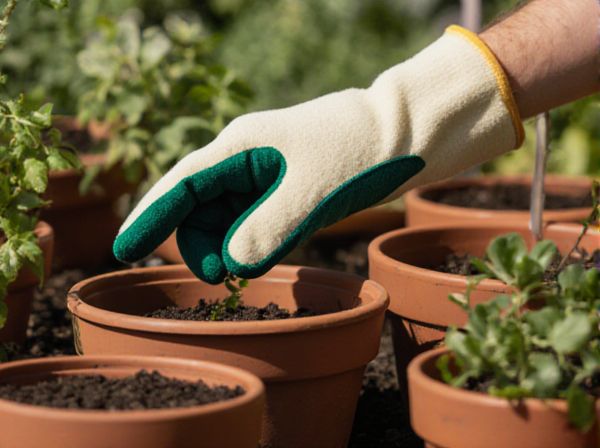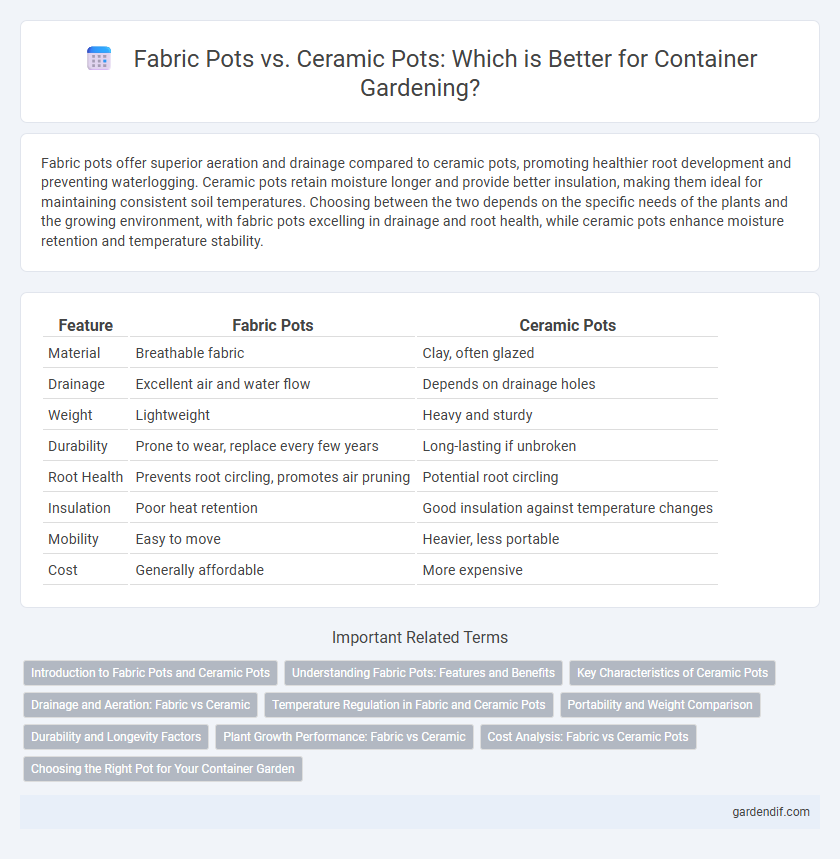
Fabric pots vs Ceramic pots Illustration
Fabric pots offer superior aeration and drainage compared to ceramic pots, promoting healthier root development and preventing waterlogging. Ceramic pots retain moisture longer and provide better insulation, making them ideal for maintaining consistent soil temperatures. Choosing between the two depends on the specific needs of the plants and the growing environment, with fabric pots excelling in drainage and root health, while ceramic pots enhance moisture retention and temperature stability.
Table of Comparison
| Feature | Fabric Pots | Ceramic Pots |
|---|---|---|
| Material | Breathable fabric | Clay, often glazed |
| Drainage | Excellent air and water flow | Depends on drainage holes |
| Weight | Lightweight | Heavy and sturdy |
| Durability | Prone to wear, replace every few years | Long-lasting if unbroken |
| Root Health | Prevents root circling, promotes air pruning | Potential root circling |
| Insulation | Poor heat retention | Good insulation against temperature changes |
| Mobility | Easy to move | Heavier, less portable |
| Cost | Generally affordable | More expensive |
Introduction to Fabric Pots and Ceramic Pots
Fabric pots are lightweight, breathable containers made from woven materials that promote air pruning of roots and improve drainage, enhancing plant health and growth. Ceramic pots, usually made from clay or porcelain, offer durability and aesthetic appeal with their solid structure but can limit airflow and retain moisture longer. Both container types serve distinct purposes depending on plant needs, environmental conditions, and gardening goals.
Understanding Fabric Pots: Features and Benefits
Fabric pots offer superior aeration and drainage compared to ceramic pots, promoting healthier root growth and preventing waterlogging. Their lightweight and flexible design enables easy mobility and storage, making them ideal for container gardening. Made from breathable materials, fabric pots regulate soil temperature and enhance oxygen flow, leading to robust plant development.
Key Characteristics of Ceramic Pots
Ceramic pots are known for their durability, offering excellent insulation that helps maintain stable soil temperatures for plant roots. They are typically heavier than fabric pots, providing better stability and resistance to tipping, ideal for outdoor use. Their non-porous surface retains moisture longer but may require careful drainage management to prevent root rot.
Drainage and Aeration: Fabric vs Ceramic
Fabric pots provide superior drainage and aeration due to their breathable material, allowing excess water to escape easily and promoting oxygen flow to plant roots. Ceramic pots, often glazed and non-porous, tend to retain moisture longer but have limited airflow, risking root rot if overwatered. Enhanced aeration in fabric pots supports healthy root development, while ceramic pots require careful watering management to avoid drainage issues.
Temperature Regulation in Fabric and Ceramic Pots
Fabric pots excel in temperature regulation by allowing superior air circulation and drainage, which prevents root overheating and promotes cooler soil conditions. Ceramic pots, while heavier and more stable, tend to retain heat longer due to their dense material, potentially increasing soil temperature and stressing plants in hot climates. Choosing fabric pots can enhance root health in warm environments by maintaining consistent, moderate root-zone temperatures.
Portability and Weight Comparison
Fabric pots offer superior portability due to their lightweight and flexible design, making them easy to move and store compared to ceramic pots. Ceramic pots are significantly heavier and more fragile, limiting mobility and requiring careful handling during transport. For gardeners prioritizing ease of relocation and space efficiency, fabric pots provide a practical alternative to traditional ceramic containers.
Durability and Longevity Factors
Fabric pots offer superior aeration and drainage, reducing root rot and enhancing plant health over time, making them highly durable for outdoor use. Ceramic pots, while heavier and more brittle, provide excellent insulation and UV resistance but are prone to cracking under extreme temperature fluctuations. Longevity in fabric pots is often extended by breathable materials that prevent soil compaction, whereas ceramic pots require careful handling to avoid chips and fractures.
Plant Growth Performance: Fabric vs Ceramic
Fabric pots enhance plant growth performance by promoting superior aeration and drainage, which prevents root rot and encourages healthy root expansion. Ceramic pots retain moisture longer but can restrict airflow, potentially leading to slower root development and increased risk of overwatering. Studies show plants in fabric pots often exhibit faster growth rates and higher yield due to improved oxygen availability and temperature regulation around the root zone.
Cost Analysis: Fabric vs Ceramic Pots
Fabric pots typically cost less than ceramic pots due to their lightweight, flexible material and lower manufacturing expenses. Ceramic pots involve higher production costs because of the firing process and heavier materials, which also increase shipping fees. Considering durability, fabric pots may need replacement more frequently, potentially balancing out the initial price advantage over long-term use.
Choosing the Right Pot for Your Container Garden
Fabric pots offer excellent aeration and drainage, promoting healthy root growth and preventing waterlogging, which is ideal for container gardens with plants requiring well-drained soil. Ceramic pots provide durability and aesthetic appeal, but often retain moisture longer and may be heavier to move, suitable for plants that prefer consistent moisture and stable container placement. Selecting the right pot depends on the specific plant species' water and root requirements as well as the garden's environmental conditions.
Fabric pots vs Ceramic pots Infographic

 gardendif.com
gardendif.com